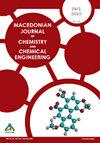Microbial potentiometric sensor technology for real-time detecting and monitoring of toxic metals in aquatic matrices
IF 0.6
4区 化学
Q3 CHEMISTRY, MULTIDISCIPLINARY
Macedonian Journal of Chemistry and Chemical Engineering
Pub Date : 2020-10-14
DOI:10.20450/mjcce.2020.2088
引用次数: 5
Abstract
Considering that toxic metals can affect metabolic processes in microorganisms adversely, it can be hypothesized that these metals in water matrices would induce a decrease in metabolic activity of the biofilm microorganisms populating the surface of a sensing electrode, which could be registered as a change in the open-circuit potential (OCP) generated by the biofilm microorganisms. The goal of this study was to test this hypothesis and demonstrate the underlying principle that microbial potentiometric sensor (MPS) technology could be used for long-term and real-time monitoring and detection of rapid changes in metal concentrations in realistic aquatic environments. To address the goal, four objective were addressed: (1) a batch reactor with three graphite-based MPS electrodes was fabricated; (2) a set of single-ion solutions and one multiple ion solution were prepared reflecting realistic concentrations of metals found in electroplating wastewaters; (3) the responses of the MPS to the simultaneous presence of multiple toxic metal ions in a single solution were measured; and (4) the changes of the MPS signals to the presence of individual metal ion solutions were examined. While the hypothesis was validated, the study also revealed that the MPS was sufficiently sensitive to not only detect, but also quantify, toxic metal ion concentrations in aqueous solutions. The coefficients of determination, which were R 2 >0.995, and responsiveness of Cd>Pb>Ag>Ni> Zn. The study provides valuable information for enforcement agents, environmental professionals, and wastewater treatment operators, so toxic metal pollution and its detrimental impacts can be prevented and mitigated.用于水生基质中有毒金属实时检测和监测的微生物电位传感器技术
考虑到有毒金属会对微生物的代谢过程产生不利影响,可以假设水基质中的这些金属会导致分布在传感电极表面的生物膜微生物的代谢活性降低,这可以记录为生物膜微生物产生的开路电位(OCP)的变化。本研究的目的是验证这一假设,并证明微生物电位传感器(MPS)技术可用于长期实时监测和检测现实水生环境中金属浓度的快速变化的基本原理。为了实现这一目标,研究了四个方面:(1)制造了一个具有三个石墨基MPS电极的间歇式反应器;(2)制备了一套反映电镀废水中金属真实浓度的单离子溶液和一套多离子溶液;(3)测定了MPS对同一溶液中同时存在多种有毒金属离子的反应;(4)考察了MPS信号在不同金属离子溶液存在下的变化。虽然这一假设得到了验证,但研究还表明,MPS不仅能够检测到水溶液中的有毒金属离子浓度,而且还能对其进行量化。测定系数为R 2 >0.995,响应性为Cd>Pb>Ag>Ni> Zn。这项研究为执法人员、环境专业人员和污水处理操作员提供了宝贵的信息,从而可以预防和减轻有毒金属污染及其有害影响。
本文章由计算机程序翻译,如有差异,请以英文原文为准。
求助全文
约1分钟内获得全文
求助全文
来源期刊
CiteScore
1.60
自引率
20.00%
发文量
14
审稿时长
>12 weeks
期刊介绍:
Macedonian Journal of Chemistry and Chemical Engineering (Maced. J. Chem. Chem. Eng.) is an official publication of the Society of Chemists and Technologists of Macedonia. It is a not-for-profit open acess journal published twice a year. The journal publishes original scientific papers, short communications, reviews and educational papers from all fields of chemistry, chemical engineering, food technology, biotechnology and material sciences, metallurgy and related fields. The papers published in the Journal are summarized in Chemical Abstracts.

 求助内容:
求助内容: 应助结果提醒方式:
应助结果提醒方式:


